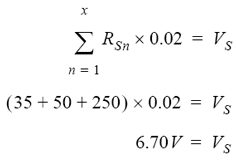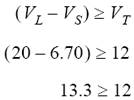How To Determine 4-20 mA Loop Load
Additional Reading:
4-20 mA Shunt Resistor and Current Loop Data Acquisition Products
Process current (4-20 mA) measurements are popular with DATAQ Instruments' customers, and that often leads to some interesting application questions. One of the better ones relates to how many process current instruments can be connected to a single current loop. Customers know that there MUST be a limit, but they're not sure about how to quantify it. This application note will answer that question so you know exactly how far you've pushed your current loop, and how much further you can go before getting into trouble.
First, here's a checklist of items that you'll need to determine process current loop load. The indicated variable for each will be used in subsequent equations that mathematically tie all the different elements together.
- Transducer compliance voltage, (VT). Process current transducers draw current from a power source in direct proportion to the mechanical quantity being measured, usually in the range of 4-20 mA. For example, a 100 psi process current transducer draws 4 mA from the power source at 0 psi, and 20 mA at 100 psi. Of course, this is a linear relationship so at 50 psi of applied pressure the transducer ideally draws 12 mA from the power source. The transducer's compliance voltage is the minimum voltage that the transducer requires from the power source to operate properly. You should find this value in the transducer's data sheet. If not, and I'm amazed at the number of times this critical specification is omitted, call the manufacturer for a value.
- Loop power supply voltage, (VL). This is the source voltage that powers the process current transducer.
- Shunt resistor values, (RSx). No instrument measures current directly. They use an indirect approach that employs a resistor in series with the process current loop (the shunt resistor) and then measure the resulting voltage drop across it. The shunt resistor is sometimes built into the instrument, and sometimes times you provide one externally. If you're using DI-8B32 or DI-8B42process current amplifiers from DATAQ Instruments, the shunt resistor is built in, and its value is 50 and 35 Ohms respectively. Determine the shunt resistor values for all other instruments connected to the loop.
You're now equipped with everything you need to determine process current loop load. Start by summing all the shunt resistor values, and then multiply by the worst case current (20 mA). This yields the voltage dropped by all the series instruments (Vs). Here's the equation in general form where variable x is the number of shunt resistors:
|
|
(1) |
Next, assemble values for transducer compliance voltage (VT) and loop power supply voltage (VL) and compare as follows:
|
|
(2) |
Equation (2) defines the condition that must exist for the transducer to operate properly. As you add instruments to a process current loop, each drops a voltage in direct proportion to the value of its shunt resistor. The sum of these voltage drops will lower the voltage that the transducer sees, and there is a point where that voltage is lower than the minimum required by the transducer to operate. Let's look at an example:
Suppose we have three instruments connected to a process current loop with shunt resistor values of 35, 50, and 250 ohms. Also assume that the minimum transducer compliance voltage (VT) is 12 V, and the loop power supply voltage (VL) is 20 V.
First, we'll determine the total voltage dropped by the shunts (VS) using Equation (1):


Since the difference between the power supply voltage and the sum of shunt voltage drops is greater than the transducer's minimum compliance voltage, this configuration works. If not, then you have the following options:
- Remove instruments (i.e. shunt resistors) until the condition is met.
- Drop the value of the shunt resistors until the condition is met.
- Increase power supply voltage, being careful to observe the transducer's maximum voltage rating.


 View Cart
View Cart sales@dataq.com
sales@dataq.com 330-668-1444
330-668-1444